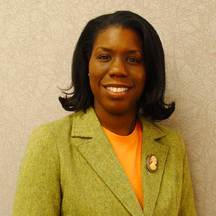 |
Camille Johnson-Arthur is executive director of the Urban AHEC. |
UNMC received funding from the Health Resources and Services Administration (HRSA) and the Urban AHEC received a subcontract award of $300,000. HRSA is part of the U.S. Department of Health and Human Services.
The goal of the new AHEC is to improve the distribution, diversity and quality of the health care workforce in medically underserved communities in its service area. The center’s efforts will encompass all of Douglas County east of 45th St., to bring together community resources to help fill the void in health care.
AHECs are community-based programs that collaborate with academic and community partners to address health care workforce needs, and health promotion and disease prevention information needs of medically underserved communities. Four rural AHECs currently are funded in Grand Island, Norfolk, Scottsbluff, and Beatrice.
Camille Johnson-Arthur, executive director of the Urban AHEC, said the center will collaborate with UNMC, Creighton University Medical Center and a variety of other community organizations and resources.
“People in this area suffer from significant health disparities and existing community resources are not sufficient to meet their health care needs,” Johnson-Arthur said. “We also will target those who, for a variety of reasons, don’t seek care. We won’t provide the health services, but we will help bridge the gap by building awareness that health services are available and where to seek them out.”
According to statistics from the 2000 census, more than 60 percent of all underserved minorities in Omaha live in the Omaha Urban AHEC service area, including 30 percent African American or mixed race, 21 percent Hispanic/Latino and 1 percent Native American, as well as large concentrations of immigrants.
About one-third of the children living in the service area are living below the federal poverty level compared to less than 9 percent in the Omaha metro area, and in some areas, almost 45 percent of children are living below the federal poverty level.
Johnson-Arthur, who was hired in April, said the Omaha Urban AHEC is charged with building an infrastructure in the community, providing cultural competency education for health professions students, building awareness and access to quality health services and providing educational and community-based health programs.
Recruiting more underrepresented minorities into the health professions is one of the new AHEC’s major goals. Efforts will include building awareness of the health professions among elementary, middle school and high school students. Plans also include health career mentor programs, continuing education and programs that meet the needs of health professionals, cultural competency training, community health education outreach programs and expanding the number of health professions students serving in underserved clinics.
Johnson-Arthur and her team have launched a pilot program with Walnut Hill Elementary School and Omaha North High Magnet School (formerly Omaha North High School) to promote fitness and health for students and family members. Fitness equipment has been installed at Walnut Hill, as well as the funding of an aerobics class. Health education has been expanded, and science fairs and summer camps have exposed third- through seventh-graders to the health sciences, Johnson-Arthur said.
She said she would like health education to start even earlier – in daycare and in Head Start programs. She plans to establish science simulation centers in north and south Omaha, and target and encourage those working in the health system to consider higher education and training in the health professions.
“This will be a place where we can have a simulated medical clinic or dental office where children will get to put on lab coats and learn,” Johnson-Arthur said. “The idea is to get more members of our underserved minority communities to be health professionals. But, I will still consider this partnership a success if we can get students to aim high and become college graduates.”
Michael Sitorius, M.D., serves as principal investigator for the Nebraska AHECS. Ward Chambers, M.D., and Theresa Townley, M.D., will provide administrative oversight of the Urban AHEC’s funding. Dr. Chambers is associate professor of cardiology and executive director of Community and Multicultural Affairs at UNMC. Dr. Townley is assistant professor of medicine and pediatrics and director of the medicine/pediatrics residency program at Creighton University Medical Center.
The Omaha Urban AHEC is housed in the Blackstone Building, 36th & Farnam streets, and is governed by a 16-member board. For more information about the AHEC, contact Camille Johnson-Arthur at 502-1207.
Omaha Urban Area Health Education Center Board Members
Richard Brown, M.D., Charles Drew Health Center;
Ward Chambers, M.D., UNMC;
Toba Cohen, Boys Town National Research Hospital;
Elan Cunningham, Nebraska Urban Indian Health Coalition;
Pat Davis, United Way of the Midlands;
Freddie Gray, Douglas County Health Commission;
Carolyn Green, Girls, Inc.;
Violet Iluebbey, Visiting Nurse Association;
Marilyn McGary, Urban League of Nebraska;
Richard O’Brien, M.D., Creighton University Medical Center;
Rubens Pamies, M.D., UNMC;
Adi Pour, Ph.D., Douglas County Health Department;
Josephine Ramos, Omaha Public Schools;
Chris Rodgers, Douglas County Board of Commissioners;
Andrea Skolkin, OneWorld Community Health Center; and
Theresa Townley, M.D., Creighton Family Healthcare.